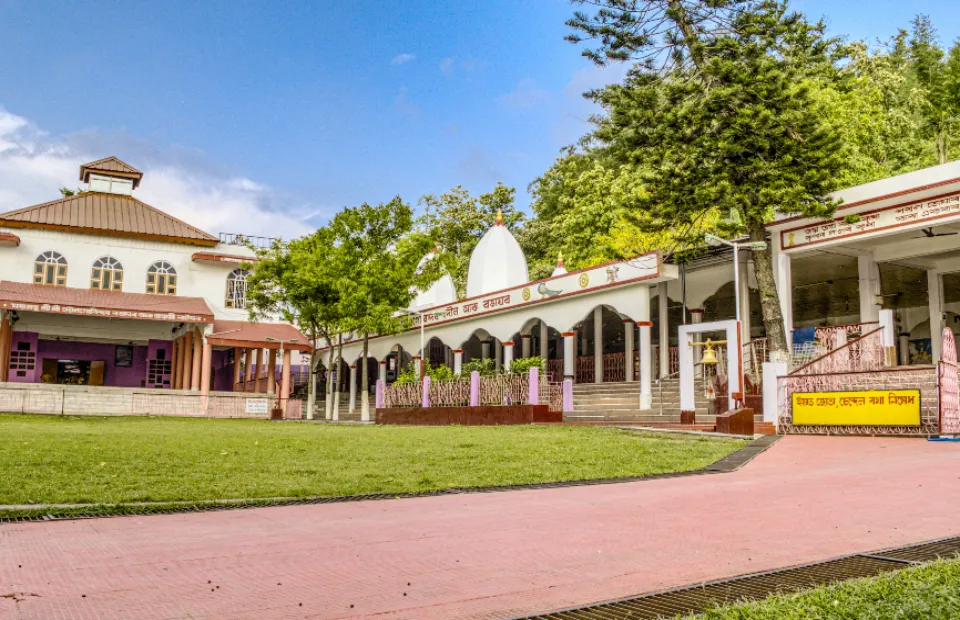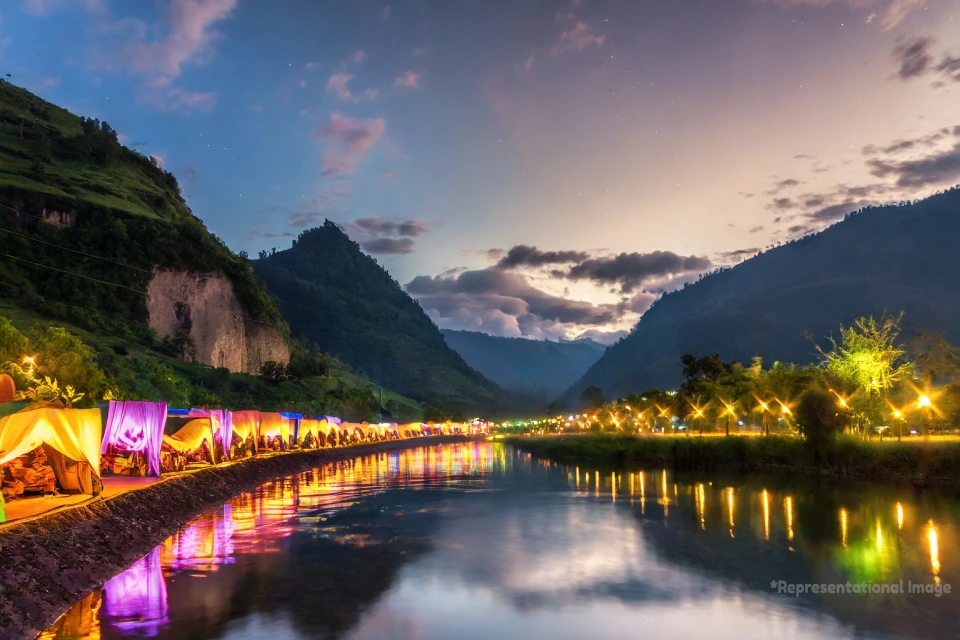Explore Doul Govinda Temple in North Guwahati, a sacred Vaishnavite site dedicated to Lord Krishna. Enjoy its peaceful surroundings and grand celebrations like Holi.
Rituparna Borgohain
Updated on :
Share this post
Among the historically significant sites in North Guwahati, Doul Govinda Temple is a renowned place of worship. This temple is dedicated to the Vaishnavite tradition of Hinduism, where Lord Govinda, or Lord Shri Krishna, is revered. Known for its deep spiritual significance, the temple attracts devotees throughout the year, especially during Doul Utsav, a grand celebration of Holi.

Let’s Explore More on Doul Govinda Temple: How to Reach There and Reasons to Visit
Location & Accessibility
Doul Govinda Temple is located on Chandra Bharati Hill in Rajaduar, North Guwahati, Kamrup district of Assam, on the banks of the Brahmaputra River.
You can reach the temple by road, ferry, or ropeway.
By Ferry: You can also reach Doul Govinda Temple by ferry from Fancy Bazar Ferry Ghat in Guwahati. Ferries operate across the Brahmaputra River to Madhyamkhanda Ferry Ghat in North Guwahati. From there, you can take an auto-rickshaw or walk a short distance to the temple. This journey offers a scenic and peaceful experience on the river.
By Ropeway: You can reach Doul Govinda Temple by taking the Guwahati Ropeway, which connects the city to North Guwahati. This offers a scenic aerial view of the Brahmaputra River and Umananda Island. From the ropeway station, you can take a short ride to the temple.
By Road: You can reach Doul Govinda Temple by road from Guwahati city via the Saraighat Bridge. The temple is around 21 km from the heart of Guwahati, and local transport like buses, taxis, and private vehicles is available.
By Air: The nearest airport is Lokpriya Gopinath Bordoloi International Airport, about 25 km away via NH 17. From the airport, you can hire a taxi or take a bus to reach the temple.
By Train: The nearest railway station is Kamakhya Junction, approximately 15 km away. You can take a taxi, bus, or auto-rickshaw from the station to reach the temple.
A Brief History of Doul Govinda Temple
A popular legend explains the temple’s origin. In 1826, after the Treaty of Yandabo, Assam came under British rule. The British ruled Assam with the help of local Assamese officials. Gargaram Baruah was the Sadar Ameen of the Nalbari district. He was the father of scholar Anandaram Baruah.
During his time, a strange event took place. It is said that in the village of Jekeria near this area, a Brahmin had a cow of Kapili color. Every night, the cow untied itself and went to the nearest Sandhyasar forest. It poured its milk on a birina tree (Chrysopogon zizanioides) and returned.
When Gargaram Baruah heard about this, he ordered an investigation. People dug the ground near the Birina tree and found a beautiful idol of Lord Krishna. Locals carried the idol in a grand procession and placed it on Chandra Bharati Hill in North Guwahati.
At that time, the temple already had an idol of Shri Shri Ghanshyam Rai. Both idols were worshipped together, but there was confusion about which one to place on the Doul (festival chariot). The priest prayed for a sign. The next morning, they saw that the newly found idol had moved four fingers ahead. Taking it as a divine sign, they placed the idol on the Doul during the festival. Since then, this idol has been worshipped as Doul Govinda.
After this, another surprising incident took place. It is said that one night, the old idol mysteriously fell from the throne. As a result, one of its hands broke. Since a broken idol is not worshipped, only Doul Govinda has been worshipped here ever since.
Fascinating Reasons to Visit
Doul Utsav—The Grand Celebration:
One of the main attractions of Doul Govinda Temple is the celebration of Doul Utsav. This Holi festival is grandly celebrated in the Assamese months of Phagun-Chot, which fall in February-March. The temple is especially famous for this festival. Doul Utsav is celebrated for five days with various rituals in a vibrant and festive atmosphere. During this time, thousands of pilgrims gather in the temple premises to take part in the celebrations.
Delight in a River Cruise and Ropeway Ride
Although one can reach the temple via the historic Saraighat Bridge, taking a ferry across the Brahmaputra River offers a unique experience. It provides a different perspective and a refreshing journey. You can enjoy the gentle waves of the river, the soothing breeze, and the scenic surroundings while sailing on the ferry, making the trip even more memorable.
Another adventurous way to reach Doul Govinda Temple is by taking the ropeway. It offers a thrilling experience while allowing you to enjoy breathtaking views of the Brahmaputra River and Umananda Temple. From the ropeway, you can capture a stunning top view on your camera, making your journey even more memorable.
Religious Significance
The spiritual significance of Doul Govinda Temple attracts devotees through its deep devotion and traditions. It is a must-visit for those seeking a divine experience. The temple’s spirituality draws devotees from across Assam, fostering a strong bond of faith.
Dedicated to Lord Krishna, it is one of Assam’s most important Vaishnavite temples. The temple embodies Assam’s rich Vaishnavite traditions and beliefs. Devotees worship Lord Krishna daily through prayers, rituals, and cultural events.
The temple celebrates Holi with great grandeur once a year. It also observes Janmashtami and other rituals dedicated to Lord Krishna. Regular aartis, kirtans, and bhajans create a serene and spiritual atmosphere within the temple.
Architectural Feature
The architecture of Doul Govinda Temple is influenced by modern architectural styles. Since the temple was renovated in 1966, its design reflects modern architectural elements.
The temple also has a Namghar, which is a traditional Assamese prayer and worship hall. In Assam, Namghars serve as places for devotional singing (Naam Kirtan) and religious gatherings. Mahapurush Srimanta Sankardeva established Namghars in Assam to promote Naam Dharma and Neo-Vaishnavism. His teachings inspired the Assamese people, leading to the widespread establishment of Namghars across Assam.
The construction of Doul Govinda Temple was completed in 1970 with the dedicated efforts of the local people and the support of devotees.
Natural retreat
This temple is situated in a beautiful natural setting. The serene surroundings of Doul Govinda Temple offer not only spirituality but also a peaceful environment. It is a perfect place to take a break from the hustle and bustle of the city. This tranquil atmosphere, combined with the gentle sounds of nature, makes it an ideal place for relaxation. The scenic beauty surrounding the temple enhances the spiritual experience, offering visitors a refreshing escape from daily life.
The Temple’s Timing
The temple schedule begins with a holy bath and offering to Lord Krishna from 6:30 AM to 7:00 AM. The temple doors open for devotees at 7:30 AM, allowing you to participate in the morning aarti.
In the afternoon, the temple remains closed at 12:15 PM for some time to offer bhog to Lord Govinda. After a short break, it reopens for darshan and remains open until sunset, when the doors close for the day.
Additionally, on Mondays, Thursdays, Saturdays, and Sundays, evening prayers and Bhagavata recitations take place in the temple.
7 Nearby Attractions to Explore After Visiting the Temple
Kamakhya Temple: One of Assam’s most important Shakti Peethas, Kamakhya Temple is about 21 km away via Amingaon-Doul Govinda Road. This historic temple is dedicated to Goddess Kamakhya and is known for its rich mythology.
Aswaklanta Temple: Just 3 km away, this temple is situated on the banks of the Brahmaputra River. It is an important pilgrimage site linked to the Mahabharata era.
Assam State Museum: Located 21.9 km away via Assam Trunk Road. However, if you take the ropeway (only 1 km from the temple), you can reach the location more easily.
Digholi Pukhuri: A historical water tank in the heart of Guwahati, linked to Mahabharata legends. It is about 24 km away via Amingaon-Doul Govinda Road. Alternatively, you can take the nearby ropeway for a shorter and more scenic journey.
Brahmaputra River Heritage Centre: Located 23 km away via Amingaon-Doul Govinda Road, or you can take a thrilling ropeway ride (just 400 m away). Situated in the heart of Guwahati, this peaceful spot is known for its scenic beauty.
Sukreswar Devalaya: Situated 21 km away via Amingaon-Doul Govinda Road. From this temple, you can easily reach Doul Govinda Temple by taking a ropeway ride (just 600 m away).
Umananda Temple: Located on Umananda Island, this temple is dedicated to Lord Shiva and is accessible via a short ferry ride from Guwahati. It offers a spiritual retreat with breathtaking views of the Brahmaputra River.
Endnotes
Doul Govinda Temple is a peaceful and spiritual place, perfect for devotion and relaxation. Its rich history, beautiful surroundings, and grand celebrations make it a must-visit. Whether you go by road, ferry, or ropeway, the journey itself is an experience. A visit here will fill you with positivity and divine blessings.

Rituparna Borgohain is a passionate explorer and writer. She is a history graduate from Sibsagar College with a keen interest in uncovering the social and cultural history of Assam. She loves exploring places and expressing the stories through her writing. Reach her at rituparna@diversityassam.com.


